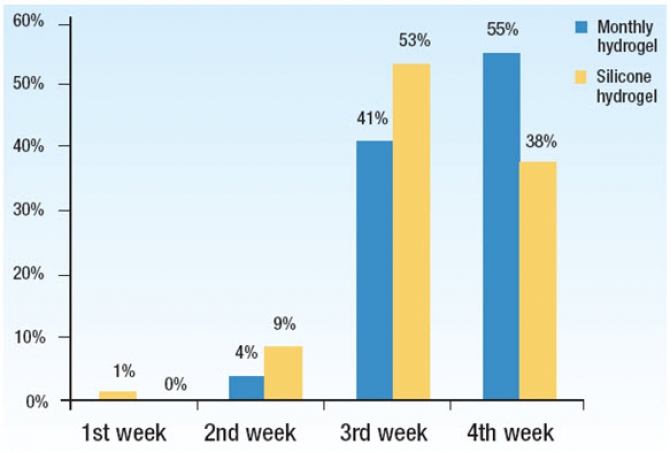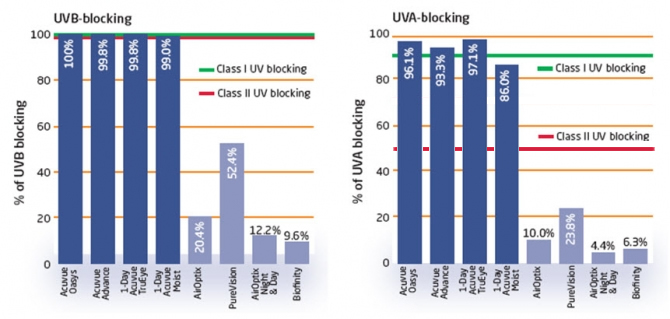Replacement frequency
There is evidence to support both clinical and comfort benefits gained by changing lenses more frequently.1,2,3 Daily disposables have been shown to have the lowest overall complications with the rate rising as replacement interval is increased.4 A survey conducted in 2007 found more than two thirds of monthly wearers noticed a decrease in comfort over the course of the month. 95% of those wearers first noticed the discomfort in either week three or four.3
Recent research investigated the wearing experience of patients in modern two weekly and monthly replacement silicone hydrogel lenses.5 Both lenses showed a performance decline across their recommended life, however the drop was slower and significantly smaller with the two weekly lens. By the end of the four week period, significantly more monthly wearers were dissatisfied with overall and end of day comfort.5
Compliance is important in any contact lens wearer, and while daily disposable has been shown to be the most compliant regime6 studies have shown no significant difference between the compliance of monthly and twice monthly lenses.6,7
For much more information on the subject of replacement frequency please download the following article by clicking here.

Results from survey asking monthly lens wearers when, on average, they started to notice discomfort.3
This video illustrates how a silicone hydrogel lens' surface deposits can increase during a month of daily wear. The amount and type of deposition will vary and is dependent on factors including, but not restricted to tear film, cleaning regimen, lens material, wear time and environment.
1. Jones, L et al. Spoilation and clinical performance of monthly vs three-monthly group II disposable contact lenses. Optom Vis Sci, 1996; 73:1 16-21.
2. Porazinski, AD and Donshik, PC. Giant papillary conjunctivitis in frequent replacement contact lens wearers: a retrospective study. CLAO J, 1999; 25:3 142-7.
3. Frangie, J, Schiller, S and Hill, LA. Understanding performance from wearers of monthly replacement contact lenses. Optometry Today, 2008; 48:12 39-42. 1. Frangie, J, Schiller, S & Hill LA. Understanding lens performance from wearers of monthly replacement contact lenses. Optometry Today 2008, 13th June 2008, 39-42 The surveyed population wore the following brands of Hydrogel contact lenses: SofLens®66 (10%), SofLens® Comfort (9%), Precision UV® (8%), Focus® (7%), Biomedics (8%), Proclear® (6%),SUREVUE® (6%), others 9%. The surveyed population wore the following brands of Silicone Hydrogel contact lenses: AIR OPTIX® (17%), PureVision® (16%) and AIR OPTIX® NIGHT and DAY® (4%).
4. Suchecki, JK et al. A comparison of contact lens related complications in various daily wear modalities. CLAO J, 2000; 26:204-213.
5. Dias, L, Young, G, Hickson-Curran SB et al. Patient comfort satisfaction during a monthly wearing schedule. Optom Vis Sci, 2010;87 E-abstract 105218.
6. Morgan PB. The science of compliance: a guide for Eye Care Professionals, 2008.
7. Jones, L, Jones, D and Simpson T. The impact of replacement frequency and care regime on subjective satisfaction with disposable/frequent replacement lenses. Optom Vis Sci. 199; 76:12s 172.
UV-blocking
An additional feature of the entire range of ACUVUE® silicone hydrogels is the incorporation of a UV-blocking component at the point of manufacture. All ACUVUE® silicone hydrogels provide the highest levels of recognised protection from UV transmission into the eye. This means they block a minimum of 99% UVB and 90% UVA radiation.*
The overview of UV exposure here (link to UV section) provides more information, including why ocular protection from UV radiation is relevant all year round even in less sunny climates such as the UK and Ireland.

*All ACUVUE® Brand Contact Lenses have Class 1 or Class 2 UV-blocking to help provide protection against transmission of harmful UV radiation to the cornea and into the eye. UV-absorbing contact lenses are NOT substitutes for protective UV-absorbing eyewear such as UV-absorbing goggles or sunglasses because they do not completely cover the eye and surrounding area. UV transmission measured with -1.00D lens. JJVC Data on file 2012.


